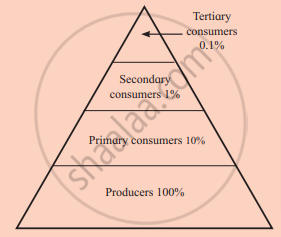Advertisements
Advertisements
प्रश्न
Describe pyramid of energy with the help of diagram.
उत्तर
- A pyramid of energy is always upright. It can never be inverted because when energy flows from a particular trophic level, only 10% passes on as net energy to the next trophic level, and a large amount of energy is always lost as heat at each step.
- In smaller food chains, more energy is available than in the longer food chains.

- There are chain limitations of ecological pyramids. It assumes a simple food chain, something that almost never exists in nature.
- It does not accommodate a food web. Moreover, saprophytes are not given any place in ecological pyramids, even though they play a vital role in the ecosystem.
APPEARS IN
संबंधित प्रश्न
“It is often said that the pyramid of energy is always upright. On the other hand, the pyramid of biomass can be both upright and inverted.” Explain with the help if examples and sketches.
Which organisms constitute the last trophic level?
“The pyramid of biomass is not always upright.” Explain the statement.
Answer the following question.
What is an ecological pyramid? Compare the pyramids of energy, biomass, and numbers.
'The pyramid of energy is always upright.' Explain
Distinguish between the upright and inverted pyramid of biomass.
Define ecological pyramids.
In a pyramid of biomass, if the total dry weight (kgm-2) of primary produces is about 809, it well increases at tertiary consumer level up to ______.
The number of trophic levels in an ecosystem are limited. Comment.
A graphic representation of the biomass relationship between the producer and consumer in an ecosystem is called ______.
